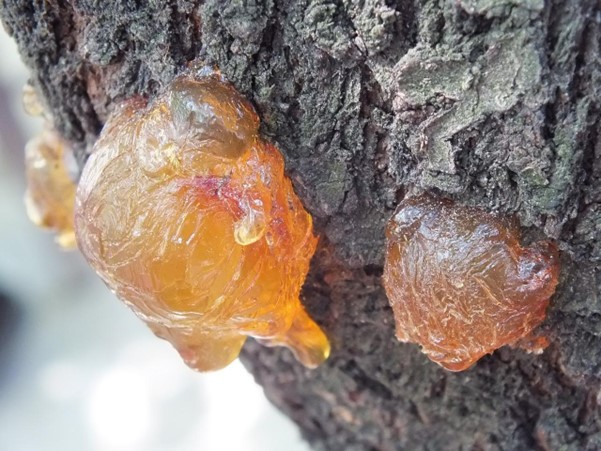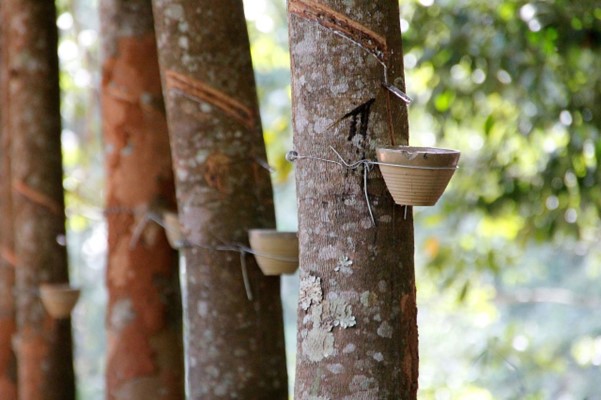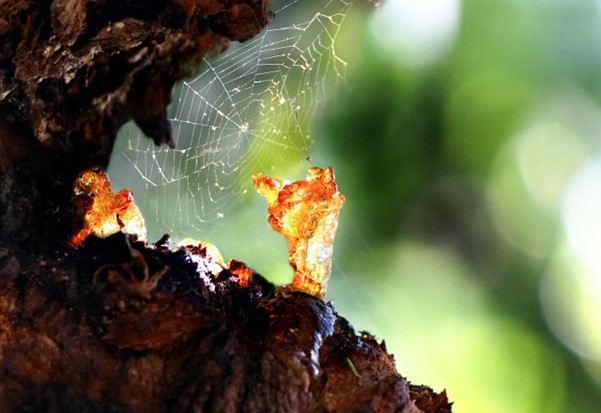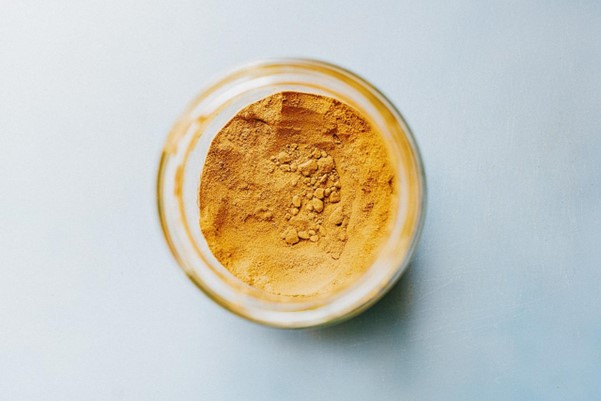Known for its detoxifying and rejuvenating properties, the herb Guggul has been used in Ayurvedic medicine for over two thousand years. Guggul is the common name for the flowering mukul myrrh tree. It is a small, thorny tree found most commonly in the dry climate of India. Guggul is also known as the resinous substance formed from the sap of this tree.

How to harvest Guggul sap?
The process of harvesting this valuable Ayurvedic product is very slow – it takes several years for the trees to mature to a point where the sap can be collected without harming the tree. When it is time to harvest, circular incisions are made on the bark of the stem, from which pale yellow, aromatic liquid oozes out.
It quickly solidifies, forming golden or reddish-brown resinous tears, which are manually scraped off with a knife. The entire procedure is repeated every 10-15 days throughout the spring from November to January.
Guggul is known by its Sanskrit name “guggulu,” which means “protects against diseases.”
What is Guggul used for?
According to Ayurveda, guggulu is related to all tissues in the body, as well as to the circulatory, digestive, nervous, and respiratory systems. Guggulu is renowned for its potent detoxifying and rejuvenating qualities, which give it a variety of beneficial properties. Here are the most important ones:
- Encourages detoxification and rejuvenation: With its ability to cleanse accumulated toxins from all organs of the body, guggulu is often used as a detoxifying agent. At the same time, it helps rejuvenate healthy tissues.
- Helps maintain healthy cholesterol levels already within normal limits: Guggulu has a remarkable ability to maintain balanced cholesterol levels. Additionally, this unique herb maintains the elasticity of artery walls and tones the heart.
- Supports healthy digestion: Thanks to its stimulating and warming nature, guggulu helps ignite the digestive fire and promotes the body’s natural digestive capacity.
- Assists in maintaining optimal body weight: Guggulu positively influences weight by removing accumulated natural toxins and excessive tissue buildup.
- Facilitates joint movement: The cleansing and detoxifying qualities of guggulu work to clear toxins from the joints, which are often a cause of pain during movement. Guggulu simultaneously lubricates and rejuvenates the tissues in and around the joints, facilitating movement in these delicate spaces.

Guggul in Ayurveda
Guggulu is a highly valued herb in the Ayurvedic tradition. From an Ayurvedic perspective, it helps balance all three doshas – Vata, Pitta, and Kapha. However, it is most renowned for its ability to alleviate aggravated Vata dosha.
In Ayurveda, it is observed that different parts of plants act on different tissues in the body. Since guggulu is made from the resin of the Commiphora mukul tree, it has a strong connection to our own “resin” or blood, known in Ayurveda as Rakta dhatu.
Guggulu also has an affinity for the Meda dhatu, or fat tissue. It helps cleanse excess unhealthy fat from the system with its sharp, bitter, and pungent taste and heating energy during digestion.
Due to its benefits for the joints, guggulu also aids in balancing the musculoskeletal system. Because of guggulu’s subtle and penetrating qualities, it is considered a yogavahi, meaning it is often used specifically to carry other substances deep into the tissues. Its combination with other herbs actually enhances its powerful detoxifying and rejuvenating qualities.

How do you consume guggul?
The Ayurvedic herb can be taken both internally as food and externally – as an ointment, as well as in the form of a visible dietary supplement.
Internal intake
Powdered Guggul
Guggulu powder is the most economical option and at the same time provides the full experience of the herb’s taste. It can be taken with water, milk, ghee, honey, or another anupan. Anupans act as a medium to deliver the herb to its intended purpose and can also enhance its effect.
Guggulu in the form of blends:
Blends are a convenient option for consuming guggulu along with other herbs. They are particularly suitable for individuals who travel frequently or for those who do not enjoy the taste of guggulu.

External intake
Guggulu in the form of traditional supplements
Since guggulu combines successfully with other herbs, it is rarely taken alone. In fact, a whole class of unique formulas, known as guggulus, is built around the use of guggulu. Powerful and effective, these compounds are made from purified guggulu and a synergistic combination of other herbs. The most commonly encountered ones include:
- Kanchanar Guggulu: The combination of triphala, trikatu, and guggulu is a powerful detoxifier and removes excess kapha from the tissues. It should be noted here that guggulu and the thyroid gland are closely related due to the herb’s influence on fat metabolism. As is known, the proper functioning of this important gland in the human body depends on metabolism and maintaining a healthy weight.
- Yogaraj Guggulu – Acts as a powerful detoxifier and rejuvenator, especially on the joints, muscles, and nerves.
- Kaishore Guggulu – The main ingredients of this mixture are guduchi, triphala, and trikatu, which, combined with guggulu, create a powerful detoxifying and rejuvenating combination, primarily aimed at removing deeply rooted pitta from the tissues.
- Punarnavadi Guggulu: This formula is very useful for clearing excess kapha from the urinary system, kidneys, heart, and joints.
- Triphala Guggulu: This classic Ayurvedic preparation minimizes the accumulation of toxins in the gastrointestinal tract, blood, and joints, promoting proper digestion and elimination. It works to reduce weight.
- Gokshuradi Guggulu: Used to strengthen and tone the kidneys, urinary bladder, urethra, prostate, and reproductive organs.
Frequently Asked Questions:
Is guggulu resin safe?
Guggulu is a potent herb and should be used judiciously. It can increase pitta, especially when combined with a pitta-aggravating lifestyle. Excessive use may lead to dry mouth, weight loss, impotence, skin disorders, dizziness, and pathological changes in the liver or lungs.
Are there any contraindications?
Guggulu should be avoided when trying to conceive, during pregnancy, while breastfeeding, and in cases of excessive uterine bleeding, thyrotoxicosis, or acute kidney infection, as well as in some allergies.
Be cautious when taking guggulu in combination with hypoglycemic drugs, lipid-lowering agents, anticoagulants, antiplatelets, antihypertensives, antidiabetic agents, or estrogens.
If you are taking any prescription medications, it is always best to consult with your doctor before starting an herbal regimen.
Conclusion:
Due to the diverse benefits of the guggulu herb, Ayurvedic medicine has been using it for thousands of years. This plant ingredient is known for its antioxidant and anti-inflammatory properties, which can support heart health, fat metabolism, joint health, and skin health.
It is also successfully used for detoxifying the body. Guggulu also possesses valuable rejuvenating effects on the skin, protecting it from wrinkles, pigmentation, and sagging.
Photos: Pixabay



0 Comments